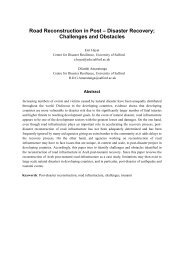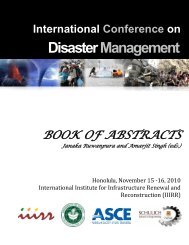Spatial Pattern of Socio-economic Landslide Vulnerability and its ...
Spatial Pattern of Socio-economic Landslide Vulnerability and its ...
Spatial Pattern of Socio-economic Landslide Vulnerability and its ...
Create successful ePaper yourself
Turn your PDF publications into a flip-book with our unique Google optimized e-Paper software.
Figure 1 Location <strong>of</strong> Study Area, Kayangan Catchment, Indonesia.<br />
3. METHODOLOGY<br />
3.1. <strong>Vulnerability</strong> Indicators<br />
<strong>Vulnerability</strong> indicators play an important role to vulnerability analysis. It should be in line with the<br />
<br />
characteristics <strong>of</strong> person or group in terms <strong>of</strong> their capacity to anticipate, cope with, resist <strong>and</strong> recover from<br />
<br />
with the three pillars <strong>of</strong> sustainable development which is pointed out to reduce vulnerability in the context<br />
<strong>of</strong> social, <strong>economic</strong> <strong>and</strong> environmental spheres (Birkmann, 2006). It explains that the vulnerability is<br />
interlinked with the individual, household or community ability to recover from disaster by strengthening the<br />
exposure, coping capacity <strong>and</strong> resilience. The complex nature <strong>of</strong> people, household, social structure <strong>and</strong><br />
culture are amongst the important features that determine how well selected indicators represent socio<strong>economic</strong><br />
l<strong>and</strong>slide vulnerability. Therefore several indicators were employed to describe exposure, coping<br />
capacity <strong>and</strong> resilience in Kayangan Catchment.<br />
Exposure is derived from building material, construction type, building age, infrastructures, <strong>and</strong> building<br />
location. Coping capacity described as capability to cope with disaster is derived from preparedness,<br />
knowledge <strong>of</strong> l<strong>and</strong>slide, age <strong>and</strong> gender. Resilience which is generally described as an ability <strong>of</strong> household to<br />
recover from disaster is derived from income, saving <strong>and</strong> building architecture representing the <strong>economic</strong><br />
welfare <strong>of</strong> a household. The indicators <strong>of</strong> <strong>economic</strong> welfare were intended to explore the <strong>economic</strong> ability <strong>of</strong><br />
household to refinance the impact <strong>of</strong> natural disaster. Several closed questions were employed to gain indepth<br />
information <strong>of</strong> preparedness <strong>and</strong> knowledge <strong>of</strong> l<strong>and</strong>slide. For instance as preparedness <strong>of</strong> evacuation<br />
route, emergency needs, important phone number, important document, participation <strong>of</strong> l<strong>and</strong>slide<br />
education/socialization, etc.<br />
The sampling technique <strong>and</strong> data mining <strong>of</strong> socio-<strong>economic</strong> l<strong>and</strong>slide vulnerability were conducted by<br />
household survey using observation, photograph analysis <strong>and</strong> interview. Household survey was conducted<br />
by transect walk <strong>and</strong> structured (closed question) interview by using questionnaire. Photograph analysis <strong>of</strong><br />
building was also used to accompany the analysis <strong>of</strong> household survey to portray the building architecture.<br />
Samples <strong>of</strong> 112 respondents were successfully aided to derive socio-<strong>economic</strong> vulnerability. Weighting<br />
3<br />
- 522 -
















